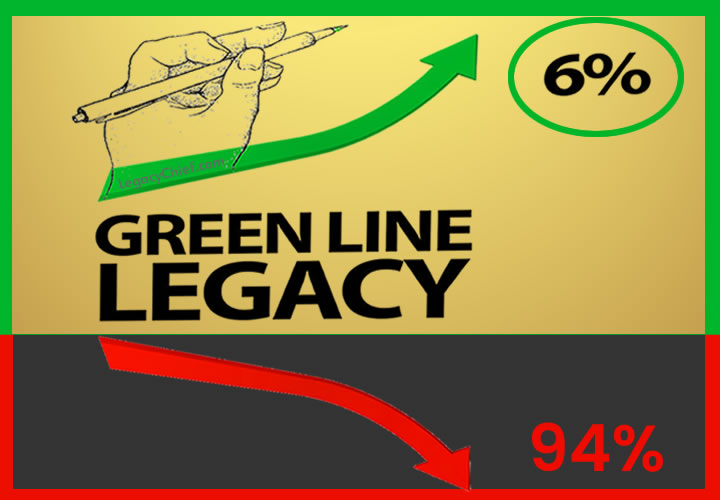Legacy Worthy ANZAC Day
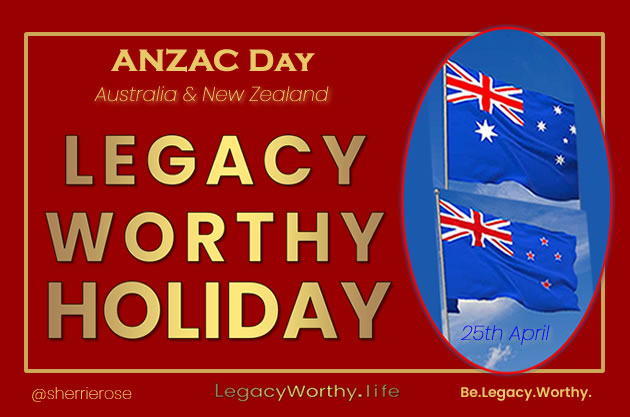
Legacy Worthy ANZAC Day
ANZAC Day – April 25th – A Legacy Worthy Day of Remembrance in Australia And New Zealand
Every April 25th, Australians and New Zealanders come together in solemn remembrance of their beloved ANZAC Day. A day dedicated to honouring the brave men and women who fought and died in service of their countries during the world wars, ANZAC Day is an integral part of both nations’ history and culture. It’s a day that stands as a reminder of our shared pasts, and of how far we’ve come from those dark days. ANZAC Day stands for Australian and New Zealand Army Corps (ANZAC),
ANZAC Day has been observed for over 100 years. The first official ANZAC Day was celebrated in 1916 on the anniversary of the Australian and New Zealand Army Corps (ANZAC) landing on Gallipoli Peninsula in Turkey during World War I. Since then, it’s become an important public holiday for both Australia and New Zealand, with events held around the country to remember those who have served their countries so selflessly.
It’s a time for reflection, contemplation, gratitude and appreciation – a chance for us all to pay our respects to those who gave so much so that we could live in peace today. From dawn services at war memorials to parades down city streets, ANZAC Day is an opportunity to come together as one nation to remember our fallen heroes.
#1 History, Significance & Meaning of ANZAC Day
ANZAC Day is a national day of remembrance in Australia and New Zealand that takes place on the 25th of April each year. It commemorates all Australians and New Zealanders who served and died in war and other military operations. ANZAC stands for Australian and New Zealand Army Corps, which was the name given to the combined forces of both countries that fought at Gallipoli during World War I. The original Anzacs landed on the beaches at Gallipoli on April 25th 1915, which is now marked as ANZAC Day.
The significance of ANZAC Day goes beyond just remembering those who died in battle; it is also about reflecting on the importance of peace, freedom, respect, courage and mateship. It’s a day to reflect on our shared history as two nations, while also coming together to remember those who gave so much for our nation. It’s a time to honour not only those who have served in conflicts since WWI, but also to commemorate those who continue to serve today.
#2 ANZAC Respectful Observation of Silence
Continuing the traditions of ANZAC Day, observing respectful silence is an important part of the day’s commemoration. This acts as a way to pay tribute to those who have served and sacrificed their lives for Australia and New Zealand. It is a time to remember and reflect on what has been given for our freedom.
The first moment of silence typically begins at 4:28am, the exact time that soldiers from both countries landed on Gallipoli in 1915. During this time, people around the world will come together in silent reflection for one minute. This has become a powerful symbol of respect and remembrance, with many people standing still or bowing their heads in honor of those who fought in World War I and other conflicts. Additionally, two minutes of silence is observed at 11am each ANZAC Day throughout Australia, New Zealand and other countries with ties to these two nations. This again serves as a reminder that we should never forget the sacrifices made by those brave men and women who gave their lives so that we can live free today.
It is through this simple but moving act of remembrance that we can truly honor those who have served our countries so courageously over the years.
#3 Dawn Service Ceremony
Every year on April 25th, Australians and New Zealanders come together to commemorate Anzac Day. A key part of this remembrance is the Dawn Service Ceremony which takes place in both countries at the break of dawn. The purpose of the service is to pay tribute to those who fought and died in wars, particularly during World War I.
The ceremony typically begins with a march by war veterans, followed by a moment of silence for those who have been lost in battle. Then there is a wreath laying ceremony which honours fallen servicemen and women. During this time, prayers are said for the departed souls and their families. Finally, hymns are sung as a sign of respect for those who sacrificed their lives for their country’s freedom. The ceremony ends with another minute’s silence before departing with a solemn mood amongst all attendees.
#4 National Anthem and Flag Raising
On Anzac Day, the Australian and New Zealand national anthems, “Advance Australia Fair” and “God Defend New Zealand” respectively, are sung by both countries. As part of the ceremony, the flags of both nations are raised. For Australians, this is a reminder of the courage, commitment and sacrifices made by those who have served in defense of their country. It’s also a sign of respect for all who’ve served in Australia’s armed forces.
The raising of the national flag is an important part of Anzac Day and is a symbol of solidarity between the two countries. It reminds us that we’re united in honouring those who fought and died for our freedoms. The flag-raising also marks a moment to reflect on the values that unite us – freedom, peace and justice.
#5 Legacy of Fallen Soldiers
The legacy of the fallen soldiers of WWI is remembered on Anzac Day. It’s a day to commemorate the sacrifice and courage of those who fought for Australia and New Zealand in the war. Each year, Australians and New Zealanders honour their brave men and women by paying their respects at dawn services, parades, ceremonies and memorials.
Anzac Day is an important part of Australian and New Zealand culture. It symbolises a shared history that binds the two countries together. It also helps remind people of the cost of war and how it can affect generations to come. This day serves as a reminder that freedom isn’t free – there’s always a price to be paid. It allows us to remember those who have made the ultimate sacrifice so we might live in peace and safety today.
Anzac Day is about more than just remembering our past; it’s about honouring all those who have served our countries. It’s about showing respect for those who have gone before us, for those still serving today, and for all future generations who will continue to fight for freedom. We owe it to them to never forget their contribution or take our freedom for granted.
#6 New Zealand War Memorial Museum
To continue the remembrance of fallen soldiers, the New Zealand War Memorial Museum is a must-visit for anyone wanting to learn more about ANZAC Day. Located in Waiouru, the museum houses an impressive collection of artifacts from wars fought by New Zealanders. Visitors can explore a variety of interactive exhibits, including a full-size replica of a World War I trench and recreations of battles from various wars. The museum also has many displays that tell the stories of those who served and sacrificed their lives during wartime. It’s truly an incredible experience to walk through these exhibits and gain a better understanding of what our brave soldiers endured.
The museum also serves as a reminder to us all to never forget those who have fought for us in times past. It’s important to keep their memories alive and remind ourselves and future generations what they went through so we can enjoy our freedom today. The New Zealand War Memorial Museum is an inspiring place that honors our fallen heroes and helps ensure that their legacy will never be forgotten.
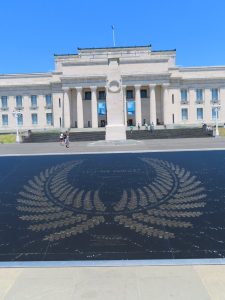
New Zealand War Memorial Museum. Located in Waiouru, NZ, formerly known as the Queen Elizabeth II Army Memorial Museum.
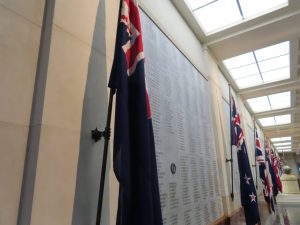


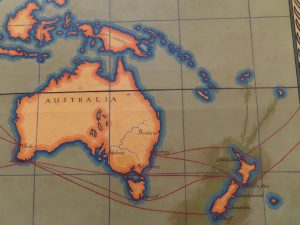
#7 Wreath Laying At War Memorials
On Anzac Day, Australians and New Zealanders gather at war memorials to lay wreaths in honour of the fallen soldiers. These solemn ceremonies are held in towns, cities and villages across both countries. While there are some differences between them, the traditional format for each wreath-laying ceremony is generally similar.
The proceedings typically start with a brief introduction from an official or dignitary. This is followed by two minutes of silence for reflection and remembrance. After this, a bugler often plays The Last Post to symbolise death and the end of battle. Participants then move forward one by one to lay their wreaths at the base of the war memorial or cenotaph. As they do so, they may recite a poem or say a few words about their loved ones who died in battle. Finally, an official will conclude the ceremony with a speech of thanks and remembrance before the crowd disperses.
#8 Commemorative March and Last Post Ceremony
An Anzac Day commemorative march is held each year, with veterans and current service personnel marching in the parade. This symbolic march helps to demonstrate the nation’s gratitude for the courage and sacrifice of those who served, and still serve, Australia and New Zealand in war. The march usually includes a wreath-laying ceremony at a local memorial or cenotaph.
The Last Post Ceremony is held in many locations on Anzac Day. It is a tradition that has been observed since World War I as a way of honouring those who died during active service. During this ceremony, a bugler plays the Last Post while people observe a minute’s silence for all those who have fallen in battles throughout history. The playing of Reveille afterwards symbolises hope for peace and freedom from war in the future.
#9 Education and Awareness Programs
Anzac Day is a time to remember those who have served and sacrificed for our country, and education and awareness programs are an important part of this. Schools across Australia and New Zealand use the day as an opportunity to teach children about the significance of Anzac Day. All levels of school – from primary to secondary – create teaching resources that help students understand why we celebrate this national day of remembrance.
In addition, there are a variety of activities that take place on Anzac Day to raise awareness about the sacrifices made by veterans. For example, each year ‘Light Up The Dawn’ ceremonies are held in cities and towns nationwide. This event encourages people to get together at dawn on April 25th for a minute’s silence in honour of those who died in battle. There are also numerous marches, exhibitions, commemorative services, and other events held throughout Australia and New Zealand that commemorate Anzac Day with respect and solemnity.
These activities provide an opportunity for citizens to honour the memory of our servicemen and women while educating people about the importance of Anzac Day in our society today. Education plays a vital role in keeping alive the spirit of Anzac so that future generations can continue to appreciate its meaning.
#10 Significance to Australia & New Zealand’s Identity
ANZAC Day is an incredibly important day for both Australia and New Zealand. It was first commemorated to honor those who served in the Australian and New Zealand Army Corps (ANZAC) during World War I. Every year on April 25th, Australians and New Zealanders come together to remember the significance of this day, as it marks a major event in their nation’s history.
The ANZACs were among the first troops to land at Gallipoli in 1915, where they bravely fought for eight months before being withdrawn due to heavy losses. This display of courage, loyalty and resilience has touched many people around the world, and over time ANZAC Day has become a symbol of pride that ties Australia and New Zealand together. It is a day to remember those who have made ultimate sacrifices serving their country, while also paying tribute to the values which define Australian and New Zealand culture: mateship, courage, strength, and loyalty. ANZAC Day is more than just a national holiday – its part of our shared identity as Australians and New Zealanders.
#11 Anzac Day Reflection for Future Generations
Having discussed the significance of ANZAC Day to Australia and New Zealand’s identity, it is important to consider its reflection for future generations. It is essential that we remember the sacrifices made by those who served in World War I and subsequent wars. We must continue to honour their legacy so that future generations understand how war has impacted our nations.
This can be done through educating individuals about the importance of ANZAC Day, as well as engaging in remembrance ceremonies each year. This will help ensure that future generations are aware of the losses endured by those who fought for our countries. Moreover, it will enable them to reflect on the courage and strength displayed by these heroes during difficult times. We must also encourage young people to take part in activities that celebrate ANZAC Day, such as dawn services or parades, so they can show respect for those who have gone before us.
It is clear that ANZAC Day should remain a significant part of Australia and New Zealand’s national identity. As such, it is paramount that we strive to ensure its reflection for future generations remains alive and well. Through education, remembrance ceremonies and participation in activities related to ANZAC Day, we can keep this important part of our nations’ history alive for years to come.
#12 ANZAC Day Memorial Commemoration
The ANZAC Day is a day of remembrance for both Australians and New Zealanders. It’s a time to honour those who have served, and sacrificed their lives in the defense of their countries. This day has grown in its significance over the years, with many ceremonies, marches and education programs being held around the country. On this day, we are reminded of the legacy of those who have fallen and will never be forgotten.
It’s important to take a moment on this special day to reflect on our past and remember those who gave so much for our future. We owe it to them to ensure that their legacy lives on for generations to come. We can do this by continuing to educate ourselves about ANZAC Day and paying respects in ways that are meaningful to us.
On ANZAC Day, let us all take a moment of silence in reverence for those who fought bravely for our freedom. May their spirit guide us through our current struggles and help shape a better tomorrow. Let us honour their memory as we proudly remember all they did for us – Lest We Forget!



